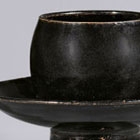J.J. Lally & Co., Oriental Art / New York City, New York
MenuPast Exhibition
Chinese Ceramics in Black and White
March 20–April 10, 2010
21.
A BLACK-GLAZED STONEWARE CUPSTAND
Song Dynasty (A.D. 960–1279)
the deep cup-shaped central support with steeply rounded sides and in-curved lipless rim, joined to a plain circular saucer with rounded sides flaring up to a plain rim, all raised on high hollow cylindrical foot, covered inside and out with a lustrous black glaze evenly applied and continuing inside the foot and over the recessed base, the edge of the foot left unglazed showing the stoneware body burnt to tan-brown in the firing.
Height 31⁄4 inches (8.3 cm)
Diameter 43⁄4 inches (12 cm)
A very similar black-glazed stoneware cupstand unearthed from the Guantai kiln site in Hebei province is illustrated in Guantai Cizhou yaozhi (The Cizhou Kiln site at Guantai), Beijing, 1997, col. pl. 22-6, with description on p. 201 and a line drawing on p. 200, pl. 86-11. The very glossy black glaze and distinctive form of this piece suggest that it is most likely that the potter was inspired by a Song lacquer prototype.
Compare, for example, the lacquer cupstand of very similar form which was excavated from a Song tomb at Heqiaozhen, Yixing county, Jiangsu province, now in the Nanjing Museum, illustrated in the Chinese Museum Series by Wenwu Publishing, in the volume on the Nanjing Museum, entitled Nanjing Bowuyuan (Nanjing Museum), Beijing, 1984, no. 116.
Compare also the Song black lacquer cupstand from the collection of the Nezu Museum, Tokyo, illustrated by Kopplin (ed.) in The Monochrome Principle: Lacquerware and Ceramics of the Song and Qing Dynasties, Museum für Lackkunst, Munich, 2008, p. 132, pl. 9, with a Song black-glazed stoneware cupstand also illustrated op. cit., p. 139, pl. 6.
宋 黑釉盞托 高8.3厘米 徑12厘米
